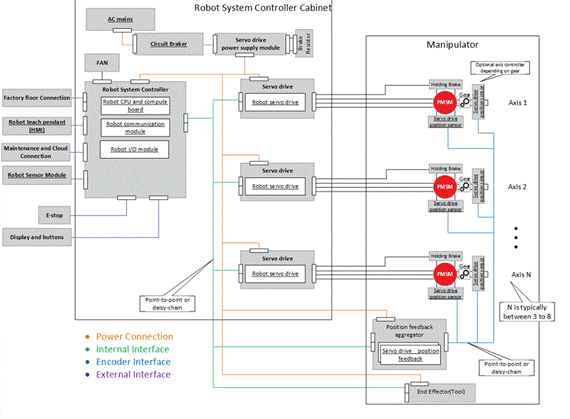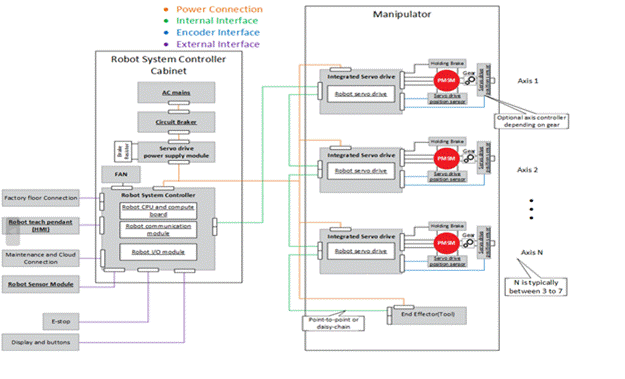How to improve system performance in robot motor control design using MCU
Time:2024-02-26
Views:215
Robot systems can automatically perform repetitive tasks, undertake complex and laborious tasks, and work in environments that are dangerous or harmful to humans. Microcontrollers (MCUs) with higher integration and stronger performance can achieve higher power efficiency, smoother and safer movement, and higher accuracy, thereby improving productivity and automation levels. For example, higher accuracy (sometimes within 0.1mm) is crucial for processing applications such as laser welding, precision coatings, inkjet, or 3D printing.


The number of axes of the robotic arm and the type of control architecture required (centralized or distributed) determine the MCU or motor control integrated circuit (IC) suitable for the system. Modern factories combine robots with different numbers of axes and degrees of freedom of motion (moving and rotating in the x, y, or z plane) to meet the needs of different manufacturing stages; Therefore, the entire factory workshop adopts different control architectures.
When choosing an MCU, choosing an MCU with additional performance margin can achieve scalability and support additional features in the future. In the design process, planning scalability and additional features in advance can also save costs and time, and reduce complexity.
This article will explore two types of motor control architectures, centralized and distributed (also known as decentralized), as well as design considerations for integrating real-time MCU to achieve these two architectures.
Centralized Architecture
In a centralized system, one MCU is used to control multiple axes. This method can effectively solve the heat dissipation problem in high-power motor drives that require large heat sinks and cooling fans (usually exceeding 2kW to 3kW). In this architecture, position data is typically obtained externally through a rotary transformer board or aggregator connected to the encoder.
Usually, in this architecture, multiple power stages are located on the same PCB or close together, so one MCU can control multiple axes. This method simplifies real-time control and synchronization between multiple axes, as multiple motor control MCUs do not require long communication lines.
The motor control MCU/MPU in a centralized architecture requires a high-performance real-time processing core (such as R5F core or DSP), a real-time communication interface (such as EtherCAT), sufficient PMW channels, and peripherals for voltage and current detection. MCUs such as AM243x can build scalable multi axis systems, providing real-time control peripherals for up to six axes and achieving real-time communication on a single chip.
In the past, FPGA or ASIC devices were mainly used for centralized motor control in automation systems. However, modern MCUs based on Arm Cortex, such as AM243x, have become increasingly popular in recent years. These MCUs have high integration and cost-effectiveness, helping designers meet the performance requirements of their systems while achieving design scalability and flexibility.
Although centralized control architecture can meet the performance and efficiency design requirements of high-power automation systems such as heavy payload industrial robots, these systems require the use of additional cables, mechanical motors connecting cabinets and joints, as well as position sensors and aggregators. These wires are not only expensive, but also prone to wear and tear and require maintenance.

Figure 1: Block diagram of a decentralized motor control architecture suitable for multi axis systems
Distributed or decentralized architecture
Recently, decentralized or distributed architectures (Figure 2) have become increasingly popular in systems with lower power requirements and have become the standard method for collaborative robotic arms.
The decentralized architecture integrates multiple single axis motor drives into each joint of the robot, and connects and synchronizes them through real-time communication interfaces such as EtherCAT. Usually, each drive controls an axis and handles certain safety functions locally. Therefore, each MCU requires real-time control and communication functions, single axis motor control peripherals, three to six PWM channels, on-chip progressive approximation register analog-to-digital converters, or Δ-Σ Modulator input.
In these applications, position sensors are usually located close to MCUs, so these MCUs require a digital or analog interface to read the data from the position sensors. Although this architecture requires more MCUs, it can significantly reduce system level costs due to the lower wiring requirements between the power bus and communication interface. Modern real-time MCUs (such as F28P65x) not only integrate all necessary peripherals, but also security peripherals, providing single or dual chip solutions for integrated axes in decentralized architectures and achieving high performance in smaller sizes.

Figure 2: Block diagram of a decentralized motor control architecture suitable for single axis systems
epilogue
Although motors may not be the most popular choice in the field of robotics today (especially compared to systems that support artificial intelligence), they are the "muscles" that maintain factory operations and a crucial part of modern manufacturing. Therefore, when selecting appropriate controller components, multiple considerations need to be considered. With the increasing integration of these devices, additional functions such as edge computing and wireless connectivity may be incorporated into motor control design.
About Texas Instruments (TI)
Texas Instruments (TI) (NASDAQ stock code: TXN) is a global semiconductor company dedicated to designing, manufacturing, testing, and selling analog and embedded processing chips for industrial, automotive, personal electronics, communication equipment, and enterprise systems markets. We are committed to making electronic products more economical and practical through semiconductor technology, and creating a better world. Nowadays, every generation of innovation is built on the foundation of the previous generation, making our technology smaller, faster, more reliable, and more affordable, thus achieving the widespread application of semiconductors in the field of electronic products. This is the progress of engineering. This is exactly what we have been doing for decades and even now.
|
Disclaimer: This article is transferred from other platforms and does not represent the views and positions of this site. If there is any infringement or objection, please contact us to delete it. thank you! |











